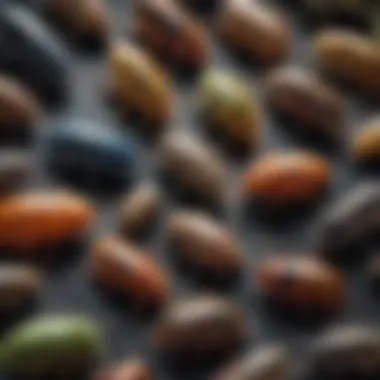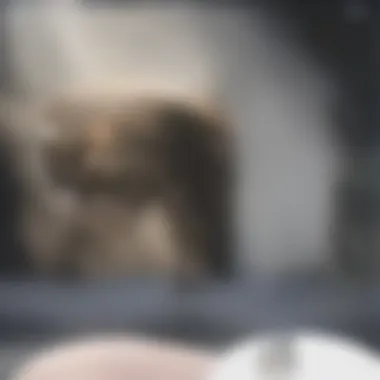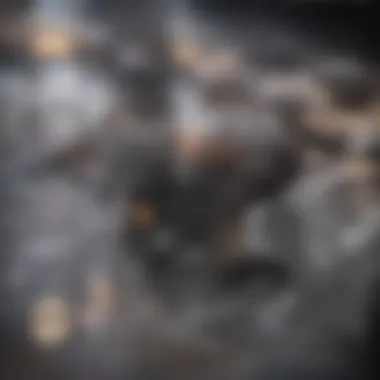Pest Control in Ireland: An In-Depth Overview


Intro
Pest control involves a range of methods aimed at managing pest populations. In Ireland, this subject demands attention due to the unique ecological balance of the region. Many pests affect both residential and commercial environments. Understanding how to effectively manage these pests is essential for maintaining health, safety, and quality of life.
Pests vary widely, including insects, rodents, and larger wildlife. Each type poses specific challenges. Public health can be compromised by pests, such as rodents and mosquitoes, which may spread diseases. Agriculture is also impacted, with pests harming crops and livestock.
A comprehensive analysis of pest control in Ireland must take into account several factors. These include the types of pests present, effective methods for control, and any existing regulations. Moreover, ecological considerations and recent advancements in technologies play significant roles in shaping pest management strategies.
In this article, we will explore the multifaceted aspects of pest control in Ireland. By synthesizing data from various studies, we aim to provide a resourceful guide. This guide will benefit researchers, practitioners, and anyone interested in pest management in Ireland.
Preamble to Pest Control in Ireland
Pest control is an essential aspect of maintaining health and safety in both residential and commercial spaces. In the context of Ireland, this issue is particularly significant due to the country's unique climate, diverse ecosystems, and varying urban-rural dynamics. Understanding pest control is crucial for several reasons. It not only addresses immediate concerns related to health risks but also safeguards crops, preserves environmental integrity, and enhances the quality of living.
When pests invade, they can cause damage to property, food supplies, and local biodiversity. For instance, certain insects can carry diseases that pose serious threats to human health. Furthermore, agricultural pests can decimate crops, impacting food security and local economies. The consequences of neglecting pest control strategies can be extensive, leading to increased infestation rates and greater difficulty in management over time.
Additionally, pest control involves various methods, which can cater to specific types of infestations. This tailored approach ensures that interventions are more effective, thus minimizing harm to non-target species and the environment. Active engagement in pest management reflects societal awareness of sustainability and the need to secure public health and safety.
Importance of Pest Control
The importance of pest control cannot be understated. It plays a vital role in safeguarding public health by preventing the spread of diseases. For example, rodents and insects such as mosquitoes are known carriers of serious infectious diseases.
- Health Protection: Effective pest management protects humans and pets from potential health threats.
- Economic Impact: Pest infestations can result in costly damages. This affects both homeowners and businesses, leading to potential revenue loss.
- Biodiversity Conservation: Unchecked pest populations can lead to the extinction of native species. Control measures ensure the protection of Ireland's rich biodiversity.
- Food Security: Agriculture is a significant contributor to the Irish economy. Protecting crops from pests is critical for maintaining food supply and economic stability.
Scope of the Issue
The scope of pest control in Ireland is broad, covering various sectors including agriculture, urban areas, and residential zones. Each area presents distinct challenges and requires specific strategies.
- Urban Areas: In cities such as Dublin or Cork, common pests include mice, rats, and various insects. The dense human population can facilitate rapid infestations.
- Rural Areas: Agriculture is susceptible to diverse pests like aphids, beetles, and slugs. Managing these pests ensures productivity and sustainability in farming.
- Legislation and Guidelines: The Irish government has established regulations to manage pest control practices, ensuring they comply with health and environmental standards.
In summary, pest control is not merely a matter of removing unwanted creatures; it encompasses strategies that impact health, economy, environment and biosecurity. Understanding its importance and scope will facilitate the development of effective management practices in Ireland.
Types of Pests in Ireland
Understanding the types of pests found in Ireland is crucial for effective pest management. Each category of pest presents unique challenges and opportunities for control. The significance of this topic lies not only in the identification but also in the implications of these pests for health, agriculture, and urban environments. By recognizing the common household, agricultural, and urban pests, stakeholders can develop targeted strategies to mitigate their impacts.
Common Household Pests
Households in Ireland often face various pest problems. Common household pests include ants, rodents, and cockroaches, each posing distinct issues. Ants, particularly the Argentine ant, can invade kitchens and disrupt food storage. Rodents such as mice and rats can damage property and spread diseases like leptospirosis. Cockroaches are nocturnal and can thrive in warm, damp locations, often spreading allergens that can affect respiratory health.
Identification of these pests is critical. Homeowners must recognize signs of infestation, such as droppings or nests. Regular inspections and maintaining cleanliness can help in early detection and prevention.
Agricultural Pests
Agriculture faces its own set of pest challenges. Key agricultural pests in Ireland include the cabbage stem flea beetle and various aphid species. These pests can lead to significant crop damage, affecting yield and quality.
Farmers must adopt diligent monitoring practices to identify pest presence. Integrated Pest Management (IPM) strategies are especially effective in agriculture. These practices may involve crop rotation, the use of resistant crop varieties, and introducing natural predators.
The economic implications are immense, as infestations can lead to reduced income and increased costs for pest control measures. Farmers should stay informed about pest populations and management solutions.
Urban Pests


Urban environments in Ireland present unique challenges in pest control. Pests like pigeons, bed bugs, and wasps can create health hazards and nuisance. Pigeons are notorious for nesting on buildings, causing damage with their droppings. Bed bugs, while not typically hazardous, can significantly impact quality of life due to their bites and the difficulty in eradication.
Wasps, which are more aggressive, can pose a risk during outdoor activities. Effective urban pest management requires collaboration between local authorities and residents. Awareness campaigns can educate communities about prevention measures. Pest control services are often needed for significant infestations.
In summary, understanding the various types of pests in Ireland is essential for developing effective management strategies. From household to agricultural and urban environments, each type of pest requires tailored approaches to mitigate their impact effectively.
Pest Identification
Pest identification is a critical component in effective pest control strategies in Ireland. Understanding the specific pests that threaten homes, gardens, and agricultural areas allows for targeted and effective interventions. Proper identification leads to better management decisions, reducing both environmental impact and economic costs associated with pest control. The earlier a pest infestation is identified, the easier and more affordable it is to manage. Moreover, correct pest identification minimizes the use of chemical controls, aligning with sustainable practices and protecting local ecosystems.
Signs of Infestation
Identifying pests early often relies on noticing signs of infestation. Various pests leave distinct indications of their presence. Here are some common signs that may alert homeowners or farmers:
- Droppings: One of the most telling signs is the presence of droppings. Different pests produce droppings of varying sizes and shapes, making them unique identifiers. For example, mouse droppings are small and pointed, while rat droppings are larger and have more blunt ends.
- Chewed Materials: Pests may gnaw on furniture, electrical wires, or food packaging. Look for frayed edges or bites on various surfaces.
- Nesting Materials: Rodents may use shredded paper, insulation, or other debris to create nests. Find these materials in hidden corners or walls.
- Strange Sounds: Many pests are active at night and may produce sounds like scratching or scuttling in walls or attics.
- Damage to Plants: In gardens, check for chewed leaves or wilting plants that may indicate insect infestations.
Being aware of these signs can significantly influence the timing and severity of pest management efforts.
Methods of Identification
Once signs of infestation are noticed, there are various methods to accurately identify the pest involved. Some of the most common methods include:
- Visual Inspection: This involves closely examining areas where infestations are suspected. Look for physical presence, including the pest itself.
- Trapping: Setting traps can not only catch pests but also help in identifying what species are present based on what is captured.
- Images and Resources: Utilizing images from resources such as Wikipedia or Britannica aids in comparison with known pest appearances. Educating oneself about pest characteristics is essential.
- Professional Help: Consulting pest control experts can provide precise identification. Specialists have the tools and experience to recognize not just the pest but also the stage of the infestation.
- Software Applications: Some tech solutions now offer identification services through pictures taken with smartphones, providing a more convenient way to diagnose pest issues.
Using these methods can enhance identification efforts and enhance pest management outcomes.
Pest Control Methods
Pest control methods play a crucial role in safeguarding both health and property in various sectors across Ireland. Understanding these methodologies is essential for effective and responsible pest management. Various approaches exist, each with distinct advantages and limitations that require consideration based on the specific pest issue being addressed.
Chemical Control
Chemical control involves the use of pesticides to manage pest populations. This method can be highly effective for quickly mitigating outbreaks. Pesticides are formulated to target specific pests, minimizing risk to non-target species when used properly. It is important to select the right pesticide, as different types work for different pests.
When considering chemical control, it is important to follow label instructions. Misapplication can not only fail to solve the issue but also pose health risks to humans and animals. Additionally, over-reliance on chemical methods can lead to resistance in pest populations, making future control efforts more difficult. Proper training and knowledge of the chemicals used must be prioritized.
Biological Control
Biological control focuses on utilizing living organisms to suppress pest populations. This can involve releasing natural predators or parasites that target specific pests. For instance, ladybugs can be introduced to control aphid populations in gardens.
This method promotes ecological balance and reduces reliance on chemical pesticides. However, successful biological control requires careful selection of the organism and understanding its impact on the local ecosystem. It is also generally slower than chemical methods in reducing pest populations, thus may not be suitable for urgent infestations.
Cultural Practices
Cultural practices encompass various agricultural and environmental management techniques that help prevent pest infestations. These practices include crop rotation, selecting pest-resistant varieties, and maintaining proper sanitation in both agricultural and residential contexts. By disrupting the life cycles of pests and eliminating potential breeding grounds, these activities significantly reduce pest pressures.
Implementing cultural practices can lead to a sustainable pest management framework. They often promote healthier plants and soil, reducing the need for chemical interventions. Monitoring and being aware of pest populations through regular inspections also help in engaging these practices effectively.
Physical Control Techniques
Physical control techniques involve non-chemical methods to deter or eradicate pests. This includes barriers like nets and traps, as well as manual removal of pests. For example, setting up sticky traps for crawling insects helps capture pests without the use of chemicals. Similarly, sealing entry points can prevent rodents from accessing buildings.
Such techniques are generally safer for the environment and human health. However, they require more hands-on effort and may be less effective for large infestations. It is necessary to combine physical controls with other methods for more extensive pest management.


"In pest control, one size does not fit all. A combination of methods tailored to the specific situation often yields the best results."
Integrated Pest Management
Integrated Pest Management (IPM) is a crucial framework in the field of pest control in Ireland. It encompasses a comprehensive strategy that integrates various management techniques to address pest problems while minimizing risks to people, property, and the environment. The primary objective of IPM is to establish effective control measures that ensure pest populations remain below economic thresholds without relying solely on chemical treatments.
Definition and Principles
IPM is defined as an environmentally sustainable approach that employs a combination of techniques aimed at managing pest populations. This approach is based on the understanding of pest biology, ecology, and the interrelationships between pests and their environment. Core principles of IPM include:
- Monitoring and Identification: Accurate monitoring of pest populations is essential. Identifying pests correctly helps to inform the best control methods available.
- Threshold Levels: Understanding the threshold levels for pest populations guides decision-making. This helps to determine when intervention is necessary.
- Control Methods: IPM advocates for a mix of techniques, including biological, cultural, physical, and chemical controls, to manage pests effectively. The emphasis is on using the least harmful methods to achieve control.
- Education and Awareness: Educating stakeholders, including homeowners and agricultural workers, about pest management practices is a vital part of IPM.
The integration of these principles allows for sustainable pest management that reduces reliance on pesticides and mitigates potential negative impacts on health and the ecosystem.
Implementation Strategies
Effective implementation of IPM in Ireland involves various strategic actions. Consider the following approaches:
- Regular Monitoring: Consistent monitoring of pest populations helps to identify issues early. Tools like traps and visual inspections are vital.
- Cultural Practices: Adjusting farming practices to enhance plant health can significantly reduce pest susceptibility. Crop rotation, proper irrigation, and selecting resistant plant varieties are examples of cultural methods.
- Biological Control: Utilizing natural predators and parasites can help to manage pest populations without chemical inputs. This requires understanding the ecosystem and selecting appropriate agents.
- Targeted Chemical Use: When chemical control is necessary, only targeted application of pesticides should be employed. This minimizes environmental impact and reduces the likelihood of resistance development.
- Training Programs: Implementing training programs for farmers and pest control personnel can enhance the understanding of IPM practices, enabling better execution on the ground.
The adoption of Integrated Pest Management practices can result in healthier ecosystems and more resilient agricultural systems in Ireland.
By following these strategies, stakeholders can achieve effective pest control while promoting environmental sustainability. The future of pest management in Ireland will increasingly rely on the principles of IPM, fostering an integrated approach to tackling pest issues.
Legal and Regulatory Framework
Understanding the legal and regulatory framework surrounding pest control in Ireland is vital to ensure that pest management practices are effective, safe, and compliant with existing laws. This section will delve into various aspects of legislation, licensing, and certification that dictate how pest control is conducted. Knowledge of these rules is crucial for professionals and organizations involved in pest control, as well as for consumers seeking to understand their rights and responsibilities.
Legislation on Pest Control
Legislation on pest control in Ireland has evolved to address public health concerns, environmental protection, and agricultural integrity. The main piece of legislation guiding pest control includes the Pest Control Act and regulations regarding pesticide use, including the European Union (EU) Regulation on the placing of plant protection products on the market. These laws govern the use and application of pesticides, requiring practitioners to adhere to strict safety standards.
The government's stance on pest control integrates not just the efficacy of pest solutions but also the potential impact on human health and the environment. For instance, certain pesticides are restricted due to their risks. Consequently, awareness of this legislation helps pest control operators choose products wisely, safeguarding both public safety and ecological balance. Compliance is regularly enforced through inspections and penalties for violations, ensuring that pest management businesses operate responsibly.
"A clear understanding of pest control laws helps prevent harm to the environment and maximizes the effectiveness of pest management practices."
Licensing and Certification
Licensing and certification are critical components of the pest control industry in Ireland. The requirement for pest control businesses to be properly licensed ensures a standard of practice that protects the public and the environment. The Department of Agriculture, Food and the Marine regulates the licensing of pest control operators, ensuring that they meet specific training and knowledge requirements.
Certification programs, such as those offered by the British Pest Control Association and other relevant bodies, are designed to enhance the skills and knowledge of pest control professionals. These certifications cover best practices, pest biology, and integrated management approaches.
Licensed operators must also undergo periodic training and demonstrate ongoing competency. This continuous education is necessary to remain informed about new regulations, emerging pests, and innovative control methods. It ultimately helps improve the success rates of pest control efforts while minimizing potential hazards associated with pest management.
Challenges in Pest Control
Pest control is essential for public health, agriculture, and environmental stewardship. However, various challenges complicate the effectiveness of pest management practices in Ireland. These challenges stem from biological, regulatory, and environmental factors that can hinder effective strategies. Understanding these obstacles is crucial for researchers and practitioners to improve pest management efficacy. The following sections delve into the specific challenges faced in pest control, including resistance development and environmental concerns.
Resistance Development
Resistance development is a significant challenge in pest control. It occurs when pest populations evolve and become less susceptible to control measures. This can happen with various methods, particularly chemical controls. For example, over-reliance on certain pesticides can lead to pests developing mutations that allow them to survive treatments. This phenomenon can severely limit the effectiveness of existing chemical strategies, requiring the constant development of new solutions.


The implications of resistance extend beyond increased pest populations. It can complicate integrated pest management strategies, as farmers and pest control operators may need to resort to increasingly potent chemicals, which can have cascading effects on the environment and non-target species. Ireland's agriculture, which relies heavily on certain pest control methods, faces the threat of reduced crop yields and increased economic costs as resistant pest species proliferate.
"Resistance management strategies are essential for sustaining effective pest control in Irish agriculture."
Environmental Concerns
Environmental concerns are another critical challenge in pest control. The application of chemical pesticides raises issues regarding soil and water quality, biodiversity, and ecosystem health. In Ireland, where agriculture is a major part of the economy, the potential side effects of pest control measures can cause significant worries among environmentalists and the public.
The runoff from treated areas can contaminate nearby water sources, impacting aquatic ecosystems and drinking water supplies. Additionally, the impact on non-target species, including beneficial insects and pollinators, can disrupt ecological balances. This disruption can lead to longer-term agricultural consequences, as ecosystems become imbalanced, impacting crop health and yields. Public perception and regulatory scrutiny regarding the environmental effects of pest control further complicate the use of traditional pesticides.
Future of Pest Control in Ireland
The future of pest control in Ireland is a critical area of exploration, particularly as the nature of pest challenges continues to evolve. Understanding this future not only assists in mitigating pest problems but also aligns pest management practices with environmental responsibilities. This section discusses the significance of technological advances and sustainable practices, two pivotal elements driving the evolution of pest control methods.
Technological Advances
Technological innovation plays a vital role in reshaping pest control strategies. The adoption of new technologies has enabled pest control professionals to employ more precise and efficient methods. Examples include the use of drones for monitoring pest populations and managing treatments in hard-to-reach areas.
Additionally, the integration of data analytics helps in predicting pest outbreaks, enabling proactive measures rather than reactive responses. For instance, software applications that analyze environmental conditions can inform pest management professionals about infestation risks, thus optimizing their interventions.
Furthermore, advancements in genetic technologies, such as the Sterile Insect Technique (SIT), offer the potential to control pest populations by releasing sterilized insects into the environment. This method minimizes the need for chemical pesticides, reducing the ecological impact. Implementing these technologies provides numerous benefits, including:
- Enhanced accuracy in pest detection
- Reduced chemical usage
- Lower operational costs over time
Sustainable Practices
Sustainable practices are increasingly becoming integral to pest control strategies. The recognition of environmental impacts emphasizes the need for methods that are both effective and eco-friendly. One major aspect of sustainable pest control is Integrated Pest Management (IPM). This approach combines biological, cultural, physical, and chemical practices to manage pest populations in an environmentally sensitive way.
Key sustainable practices involve:
- Utilizing Natural Predators: Encouraging the presence of natural enemies, such as beneficial insects, to manage pest populations.
- Crop Rotation: This practice disrupts pest life cycles and reduces pest pressure in agricultural settings.
- Ecological Monitoring: Regular observation of ecosystems helps in understanding pest dynamics and assessing the effectiveness of controls.
By incorporating these methods, pest control can become more aligned with conservation efforts.
"Pest control is not just about elimination; it's about management that safeguards our environment and biodiversity."
In summary, both technological advancements and sustainable practices are the cornerstones of future pest control in Ireland. As strategies evolve, they will enhance efficacy while prioritizing ecological well-being.
Adopting these approaches prepares pest management for the challenges of tomorrow while fostering responsibility toward the environment.
Finale
The conclusion of this article serves as a crucial component, encapsulating the multifaceted discussions surrounding pest control in Ireland. Highlighting the key aspects addressed, it distills the complex interplay between pest management practices, ecological implications, and regulatory considerations. Understanding this interplay is vital for stakeholders ranging from homeowners to industry professionals.
Summary of Key Points
The examination of pest control in Ireland has revealed several critical insights:
- Diverse Pest Populations: Various types of pests inhabit Ireland, from common household insects to agricultural nuisances. Each requires specific strategies for effective management.
- Control Methods: The integration of chemical, biological, and physical controls, along with cultural practices, offers a comprehensive toolkit for pest management.
- Regulatory Framework: Ireland's legal landscape provides essential guidelines for pest control practices, ensuring that methods employed are both safe and effective.
- Challenges and Innovations: Issues surrounding resistance development and environmental concerns remain prevalent.
- Future Directions: Innovations in pest control technologies and sustainable practices offer promising avenues for more effective and responsible pest management solutions.
Understanding these key aspects cultivates a stronger foundation for informed decisions regarding pest control.
Call for Responsibility
The responsibility for effective pest management does not rest solely on regulatory bodies or professionals; it is also a shared duty among the general public. Homeowners and businesses must become proactive participants in pest control initiatives. This commitment entails:
- Educating Oneself: Being informed about local pests and effective management strategies is essential. Resources are available through local environmental agencies and educational institutions.
- Adopting Preventative Measures: Simple actions, like maintaining cleanliness and structural integrity, can significantly reduce pest attractants.
- Sustainability: Embracing eco-friendly practices in pest management helps mitigate potential impacts on biodiversity and the environment.
- Engagement in Community Efforts: Collaborating with local pest management programs can further enhance the effectiveness of pest control efforts across neighborhoods.
"An informed public is the best defense against pest-related issues. Education and community engagement can make a significant difference in effective pest control."















